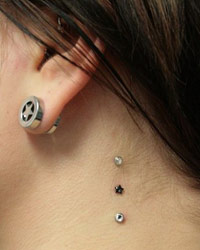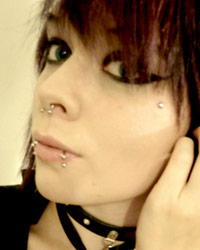Your cart is empty :/
History, Origin, Care, Healing of Microdermal Piercing
Microdermal piercing (short for "micro-transdermal implant") was born in the USA in the early 2000. It is also called micro transdermic in french (short for "micro-transdermique"). The transdermal piercing is actually an evolution of the micro-piercing (these little surface rings) and of the surface piercing in general. It actually refers to what we call a transdermal implant, as you could imagine.
We also sell piercings and here is an overview of our best sales:

Photo: 2Face-Tattoo
Microdermal piercing is a real revolution in the world of piercing. Its rejection rate is very low compared to surface piercings. Moreover, they can be implanted rapidly nearly anywhere on the body; the possibilities of locations are multiplied, and it is possible to imitate a surface piercing with two microdermal piercings.
Since its creation, microdermal piercing evolved in different forms (external thread, different shape of the base, etc...). The last evolution is the "Skin Diver", much smaller and without any ornemental screwing. The base is round, generally a little disc.
All microdermal piercing bases must be in titanium G23, such as those we sell at our online shop. The ornaments, on the other hand, can be in surgical steel 316L.

Photo: chameleonkitty
Care and Healing for Microdermal Piercing
2 weeks of care and 3 months of healing are usually necessary. Healing of microdermal piercing is faster than a surface piercing.
Piercing care are usually simple: clean twice a day the piercing with neutral PH soap in order to remove any secretion (blood, lymph, etc...) then rince with saline. Do not forget to wipe the area to let the piercing breathe.
Tip: in order to ease the cleaning, it is advised to use cotton swabs to rub the soap and for drying. Do not hesitate to press firmly the extremity of the cotton swab in order to give it a flat shape and slip it more easily under the jewel. Do not hesitate to use a full dose of saline each time and rince your piercing on every side.
Implanting the Microdermal Piercing
The implant of microdermal piercing takes generally longer than any other kind of piercing. It is generally practiced with a "dermal punch", a kind of needle rather large which can dig the skin, kind of like coring. The skin is dug from the top then on the front and on the back, as to prepare the hole that will host the base of the microdermal piercing. The technic may seem a little barbarian, but the pain is totally bearable and way less intense than what we can imagine, it's even surprising! The jewel is then inserted in the whole with a special clamp allowing to hold it by its extremity. The implant can also be done with a scalpel or a needle.
It is then totally possible to remove the jewel with a scalpel, leaving a scar barely visible. If the jewel of the microdermal piercing is torn unwillingly, it is possible to put it back depending on the elasticity of your skin and the shock suffered. If it happens, you must check that it still fits the surface of the skin after putting it back, and that it is not misplaced. If it is misplace, the chance of rejection are almost 100%.






Be the first to post a comment!